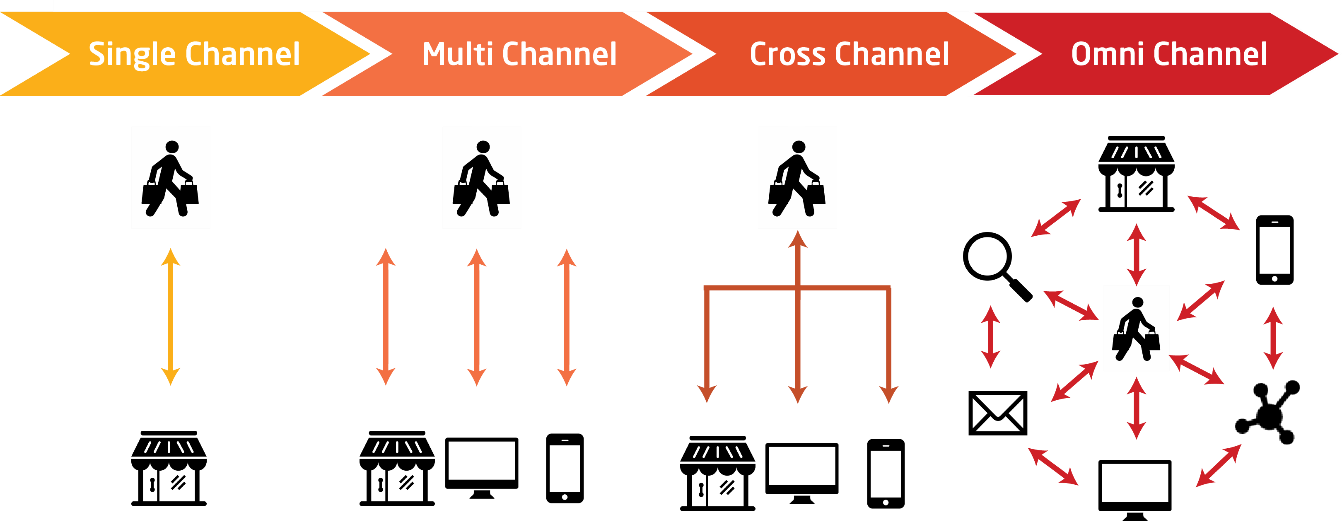8 important marketing lessons from omnichannel customer behavior
Learn 8 important marketing lessons from omnichannel customer behavior, including omnichannel retail, omnichannel marketing, and omnichannel customer experience.

What can we learn from the consumer behavior of omnichannel customers?
Today's omnichannel customers interact with businesses across different channels and devices, and they expect a seamless experience across all possible touchpoints.
How much do you know about these omnichannel customers – and how can your business evolve to better serve their needs? There's a lot you can learn from observing omnichannel customer behavior.
Key takeaways
-
Omnichannel customers buy more than traditional customers
-
Omnichannel customers start their journey online, visit multiple channels, and often want to order online and pick up in a physical store
-
Omnichannel customers expect a seamless and personalized experience across multiple channels
-
Omnichannel customers will buy more when they can fully experience the product in advance
What is omnichannel?
We live in an omnichannel world. People use multiple devices to access information across a variety of online channels – social media, websites, and more. People don't limit themselves to a single source of information; they expect to find what they want wherever, whenever and however they're looking.
People also don't limit themselves to a single channel when they're shopping. Some people like to shop online. Others like to shop in physical stores.
Still others prefer multi-channel retailing, sometimes spreading their customer journey across several channels.
Wherever customers go and however they interact with you, they expect a consistent and seamless experience. To reach today's omnichannel customers a business needs to embrace omnichannel in all its forms – at retail, in marketing, offline and with the customer experience.

Omnichannel retail
Omnichannel retail— sometimes called omnichannel commerce— is an approach to selling that offers the retailer's products across multiple channels – both online and in physical stores. Not only can customers purchase from multiple channels, they can also shop online and pick up in-store, or shop in-store and order via app for home delivery.
The following video explains more about how omnichannel commerce works.
Omnichannel marketing
Omnichannel marketing involves the promotion of a company's products and brand across multiple channels and media. This can include:
-
Company website
-
Email
-
Online advertising
-
Social media
-
Search engines
-
mobile apps
-
mobile channels
-
in-store promotions
-
offline channels
Key to omnichannel marketing is presenting a consistent image and message across all of these channels, while fine-tuning that message for each specific channel.
Omnichannel CX
An omnichannel CX (customer experience) is a seamless and often personalized experience that follows customers as they interact across multiple channels. The omnichannel CX informs both omnichannel retail and omnichannel marketing and provides a true customer focus across all touchpoints. The omnichannel CX also applies to other forms of customer interaction, including customer service, technical support, billing, and post-sale reviews and ratings. It is a holistic and data-driven approach to interacting with customers.
What can we learn from purchase intentions of omnichannel consumers?
What do we know about consumer behavior from the omnichannel experience? Data collection efforts all point to the effectiveness of omnichannel commerce and marketing.
1. Omnichannel customers buy more
Omnichannel customers buy more and more often than do traditional customers. Customers who engage with three or more channels buy 250% more frequently than those who only engage with a single channel. These same omnichannel customers spend 13% more than non-omnichannel customers. They're also 90% more likely to be repeat purchasers.

2. Omnichannel customers start their journey online
One common factor of omnichannel customers is that they start their purchasing journey online. According to Forrester's The State of Commerce Experience 2021 report, 44% of B2C customers (and 58% of B2B buyers) research a project online before they head to a physical retailer. Almost half continue their online research while shopping in a physical store, typically by comparing the in-store prices to those of online retailers.
3. Omnichannel customers visit multiple channels
As might be expected, omnichannel customers aren't loyal to a single channel. They visit multiple channels in their day-to-day journeys, using their phones, their computers, and other devices to interact online. According to a study by the Harvard Business Review, 73% of customers use multiple channels when shopping for a product. This true even for B2B customers, who regularly use 10 or more channels to interact with their suppliers.
4. Not all omnichannel customers visit all channels
Even though today's consumers are overwhelmingly omnichannel, that doesn't mean they utilize all available channels. No two omnichannel customers are alike – some prefer getting information from social media and review sites, others like to search Google for information, still others prefer to get their information directly from a company's official website. When planning an omnichannel strategy, it's important to learn what channels your customers prefer and focus your efforts there.
5. Omnichannel customers want a personalized experience
Wherever and however customers interact with you, they increasingly expect a personalized experience – and they'll pay more for it. In a recent survey, 86% of consumers said they'd pay more for a better customer experience. Conversely, 32% of consumers said they'd abandon a brand after just one bad experience. The more you can personalize the customer experience across multiple channels, the more loyal your customers will be.
6. Omnichannel customers expect a consistent message and experience across all channels
The omnichannel experience is all about providing a consistent message and experience to customers across all channels and touchpoints. Customers want to be able to start an interaction on one device and seamlessly resume it on another. They don't want to reenter personal information on their computers when they've already provided it on their phones. They want to be presented with the same products and pages they were viewing on their phones when they move to their computers. They don't want to see different offers or pricing when they interact with you in different ways.
In this fashion, the omnichannel experience is all about consistency — consistency in messaging, consistency in branding, consistency in how customers interact with you. If you don't provide a seamless omnichannel experience, customers will abandon you for a competitor that does.
7. Omnichannel customers want to experience a product before they buy
One thing that almost all shoppers have in common is that they need to fully experience a product before they make a purchase. This can happen in a number of ways. They can visit a physical store and literally touch and feel a product. They can read copious amounts of detail about a product online. They may even be able to use AR and VR to experience a product virtually on a company's website.
Customers who want to touch and feel a product may shop online but make their final purchase in a physical store. Customers who are more comfortable getting their information online may finish their purchase on an ecommerce website – and the more information you can give them, the more likely they are to complete the purchase. (A Shopify survey found that providing 3D augmented reality models increase sales by 250%.)
8. Omnichannel customers want to buy online and pick up in store
Finally, now that omnichannel retail is becoming increasingly propelled by customers who want to buy online and pick up in store (BOPIS). This trend is driven by several factors, including:
-
Privacy concerns (customers don't want to share personal data online)
-
Shipping costs (customers don't want to pay for online shipping; they'd rather order online and pick up for free from a local store)
-
Shipping time (customers want their purchases today, not later in the week)
This argues for linking your online and physical operations so customers can order on their phones or computers, find out if an item is in-stock, and be able to pick up their orders as quickly and conveniently as possible.
Let Optimizely help you optimize your omnichannel experience
When you want to create a seamless, consistent, and effective omnichannel experience for your customers, turn to Optimizely. Our Digital Experience Platform helps you deliver the personalized omnichannel experience that today's omnichannel customers demand, across every possible touchpoint.
